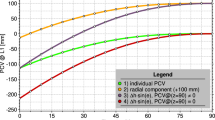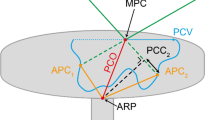Abstract
To better understand how receiver antenna calibration models contribute to GPS positioning error budget, we compare station positions estimated with different calibration models: igs05.atx, igs08.atx and individual antenna calibrations. First, the impact of switching from the igs05.atx antenna calibration model to the igs08.atx antenna calibration model is investigated using the EUREF Permanent Network historical data set from 1996 until April 2011. It is confirmed that these position offsets can be effectively represented by the igs05.atx to igs08.atx latitude-dependent model. Then, we demonstrate that the position offsets resulting from the use of individual calibrations instead of type mean igs08.atx calibrations can reach up to 1 cm in the up component, while in the horizontal, the offsets generally stay below 4 mm. Finally, using six antennas individually calibrated by a robot as well as in an anechoic chamber, we observe a position agreement of 2 mm in the horizontal component and a bias of 5 mm in the up component. Larger position offsets, dependent on the antenna/radome type, are, however, found when these individual calibrations are compared to type mean calibrations of two tested antennas.





Similar content being viewed by others
Explore related subjects
Discover the latest articles, news and stories from top researchers in related subjects.References
Altamimi Z, Collilieux X, Métivier L (2011) ITRF2008: an improved solution of the international terrestrial reference frame. J Geod 85:457–473. doi:10.1007/s00190-011-0444-4
Bruyninx C, Habrich H, Söhne W, Kenyeres A, Stangl G, Völksen C (2012) Enhancement of the EUREF Permanent Network Services and Products, Geodesy for Planet Earth, IAG Symposia Series, 136: 27–35. doi:10.1007/978-3-642-20338
Dach R, Hugentobler U, Meindl M, Fridez P (eds.63) (2007) The Bernese GPS software version 5.0, Astronomical Institute, University of Bern
Defraigne P, Guyennon N, Bruyninx C (2008) GPS time and frequency transfer: PPP and phase-only analysis. Int J Navig Obs 2008, Article ID 175468. doi:10.1155/2008/175468
Dilßner F, Seeber G, Wübbena G, Schmitz M (2008) Impact of near-field effects on the GNSS position solution. Proceeding 21st International Technical Meeting of the Satellite Division of The Institute of Navigation (ION GNSS 2008), p 612–624
Dow JM, Neilan RE, Rizos C (2009) The international GNSS service in a changing landscape of global navigation satellite systems. J Geod 83:191–198. doi:10.1007/s00190-008-0300-3
Görres B, Campbell J, Becker M, Siemes M (2006) Absolute calibration of GPS antennas: laboratory results and comparison with field and robot techniques. GPS Solut 10(2):134–145. doi:10.1007/s10291-005-0015
Kouba J, Heroux P (2001) Precise point positioning using IGS orbits and clock products. GPS Solut 5(2):12–28. doi:10.1007/PL00012883
Lesparre J (2006) The impact of the antenna mounting on the phase centre variation. EUREF Symposium 2006 Link: http://www.euref.eu/symposia/2006Riga/05-03.pdf
Mader G (1999) GPS antenna calibration at the National Geodetic Survey. GPS Solut 3(1):50–58. doi:10.1007/PL00012780
Rebischung P, Griffiths J, Ray J, Schmid R, Collilieux X, Garayt B (2011) IGS08: the IGS realization of ITRF2008. GPS Solut 16(4):483–494. doi:10.1007/s10291-011-0248-2
Rothacher M (2001) Comparison of absolute and relative antenna phase center variations. GPS Solut 4(4):55–60. doi:10.1007/PL00012867
Rothacher M, Gurtner W, Schaer S, Weber R, Schluter W, Hase HO (1996) Azimuth- and elevation-dependent phase center corrections for geodetic GPS antennas estimated from GPS calibration campaigns. In Beutler G, Hein GW, Seeber G, Melbourne WG (eds), GPS trends in precise terrestrial, airborne, and spaceborne applications: International Association of Geodesy Symposia, Boulder, CO, July 3-4, 1995. Springer-Verlag, New York, 115:333–338 doi: 10.1007/978-3-642-80133-4_56
Schmid R, Mader G, Herring T (2005) From relative to absolute antenna phase center corrections. Meindl M (ed.) Proceedings of the IGS Workshop and Symposium 2004, Astronomical Institute, University of Bern, 2005 http://igscb.jpl.nasa.gov/igscb/resource/pubs/04_rtberne/Session10_1.pdf
Wübenna G, Schmitz M, Menge M, Seeber G, Völksen C (1997) A new approach for field calibration of absolute GPS antenna phase center variations. navigation. The Institute of Navigation, 44(2):247–255, Summer, USA
Wübenna G, Schmitz M, Boettcher G, Schumann C (2006) Absolute GNSS Antenna calibration with a robot: repeatability of phase variations, calibration of GLONASS and Determination of carrier-to-noise pattern, Proceedings of the IGS Workshop 2006, Germany, 2006 ftp://igscb.jpl.nasa.gov/pub/resource/pubs/06_darmstadt/IGS%20Posters%20PDF/p_Schmitz_gppigs06_pabs_i.pdf
Zeimetz P (2010) Zur Entwicklung und Bewertung der absoluten GNSS-Antennenkalibrierung im HF-Labor1. PhD Thesis, Rheinischen Friedrich-Wilhelms-Universität Bonn, Germany, p 1–132
Acknowledgments
This research is supported by the Solar Terrestrial Center of Excellence. The authors would like to thank Dr. M. Schmitz from Geo ++ for providing detailed information on type mean calibrations. Thanks to P. Rebischung from the Institut National de l’Information Géographique et Forestière for his help and comments on his model and to Dr. R. Schmid from the Deutsches Geodätisches Forschungsinstitut for his valuable comments on the IGS antenna calibrations. The authors would also like to thank the editor and the reviewers for their constructive comments on the manuscript.
Author information
Authors and Affiliations
Corresponding author
Rights and permissions
About this article
Cite this article
Baire, Q., Bruyninx, C., Legrand, J. et al. Influence of different GPS receiver antenna calibration models on geodetic positioning. GPS Solut 18, 529–539 (2014). https://doi.org/10.1007/s10291-013-0349-1
Received:
Accepted:
Published:
Issue Date:
DOI: https://doi.org/10.1007/s10291-013-0349-1




